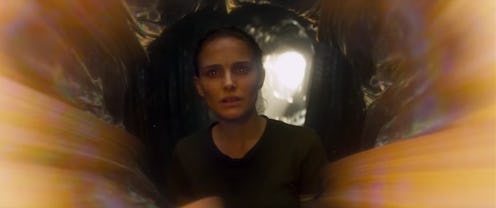Entertainment
We Have To Talk About That Totally Bonkers Ending Of 'Annihilation'

Spoilers ahead. The world "annihilation" doesn't just mean destruction. In physics, annihilation is actually a form of creation, as defined by Merriam-Webster: "the combination of a particle and its antiparticle... that results in the subsequent total conversion of the particles into energy." This definition is crucial when it comes to understanding what the Annihilation ending means. This isn't to say that there is only one right way to experience the ending of Alex Garland's new science fiction film. Annihilation is the kind of movie that lends itself to infinite interpretations, and that's by design. However, before getting into what the Annihilation ending really means, it's important to know what actually happens.
The last act of Annihilation either answers all of your questions or explains nothing. After embarking on an expedition into the mysterious Shimmer that has changed the ecosystem of its area, biologist Lena (Natalie Portman) finally reaches the end of the journey: the Lighthouse where the Shimmer originated. There, she finally sees the source of the Shimmer, a strange, extra terrestrial like energy that is constantly shifting and changing and turns Dr. Ventress (Jennifer Jason Leigh), the leader of the expedition, into what can only be described as a ball of energy. This ball of energy then becomes a double of Lena, thanks to a strategically absorbed drop of blood, and the two Lenas fight, both desperate to be the one to leave the Lighthouse.
It looks like Lena, the Lena who went into the Shimmer, is victorious, and she returns home to be with her husband, Kane (Oscar Isaac) the only other person to have survived a trip into the Shimmer. But are they the same Lena and Kane that went into the Shimmer or are they something else?
Neither Lena nor Kane seem sure of who or what they are. Video footage in the Lighthouse suggests that this Kane, the one who returned, is a being made of the Shimmer, but is he? There's no real way to know. When asked if he's really Kane, he answers that he doesn't think so. And when Lena is asked if she's really Lena, she doesn't answer. The duo hug in silence instead, their eyes seemingly reflecting the multi-colored lights of the Shimmer.
So, are Kane and Lena human? Are they alien? Did the Shimmer somehow replicate them and take their place, or did it just change them on a cellular level? Thinking about how physics defines "annihilation," one interpretation of the ending is that Lena and Kane aren't quite the same Lena and Kane they once were. Though they share physical characteristics with their old selves, their DNA has been fundamentally altered. Both collided with the Shimmer violently (literally, they both fought themselves in the Lighthouse) to become a new form of energy, a new being.
This theory is backed up by one of the central themes in the original book by Jeff VanderMeer, specifically the importance placed on proper nouns. As reported by Uproxx, VanderMeer's writing is careful not to name anything — characters, creatures, places, they are all mostly unnamed and unspecified. Though Garland's adaptation forgoes this detail, the last scene brings the importance of proper nouns to the forefront when Kane and Lena ask each other if they are the real Kane and Lena they were before. They use their specific names, proper nouns, to question each other, calling into question the very nature of what those names actually mean.
Assuming both Lena and Kane are somehow new embodiments of the Shimmer, can they still be called "Lena" and "Kane"? Should they have new names altogether, or are their names something they retain even as they become something new? The ending of Annihilation doesn't provide answers to these questions. When VanderMeer first saw the film, he described the ending as "mind-blowing" while speaking on The Watch podcast, via Collider, and he's not wrong. Whatever the ending really means is something every viewer will have to decide for themselves, right after putting their minds back together again.
This post was originally published on Feb. 22, 2018. It was updated on Aug. 22, 2019.